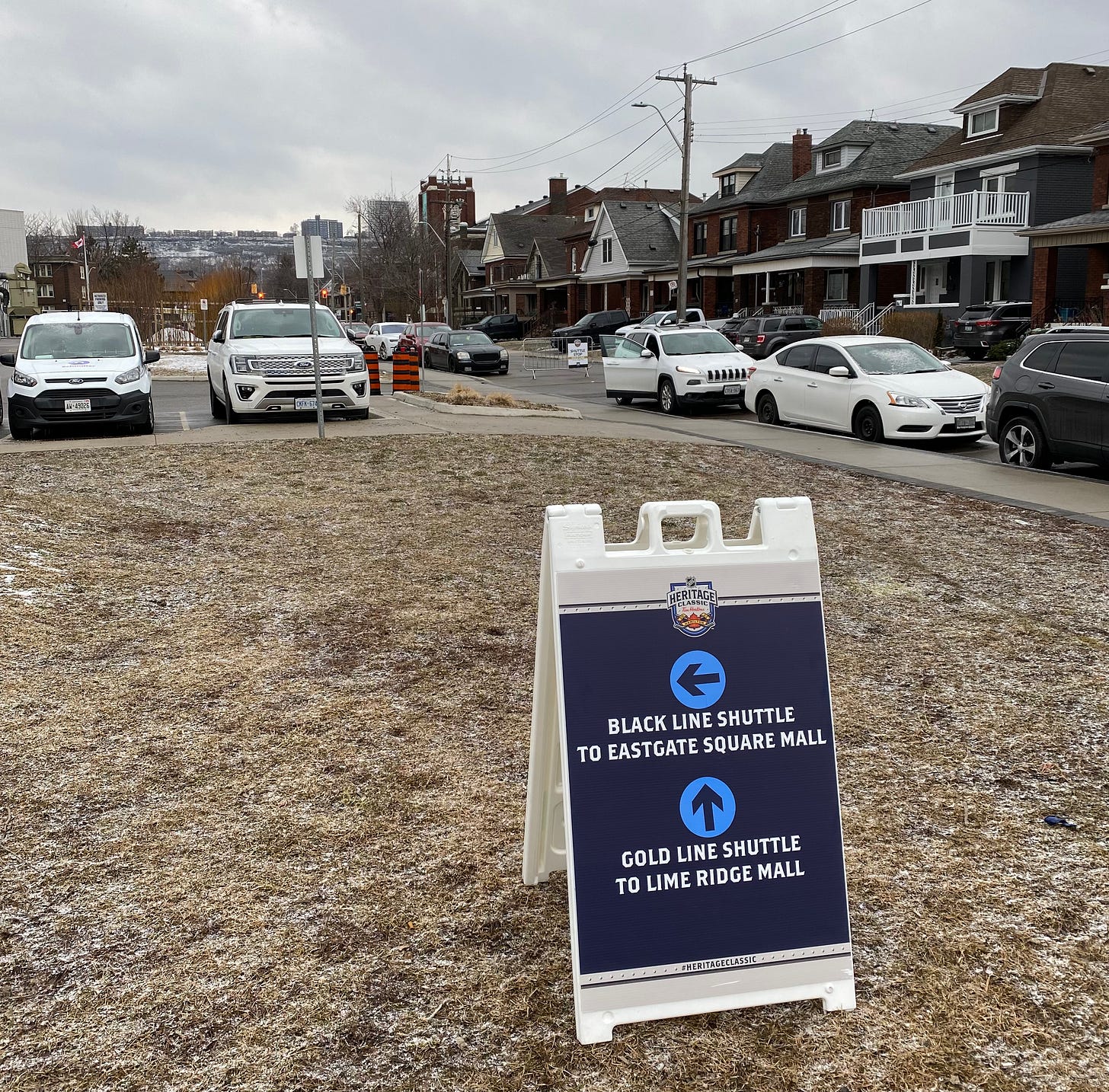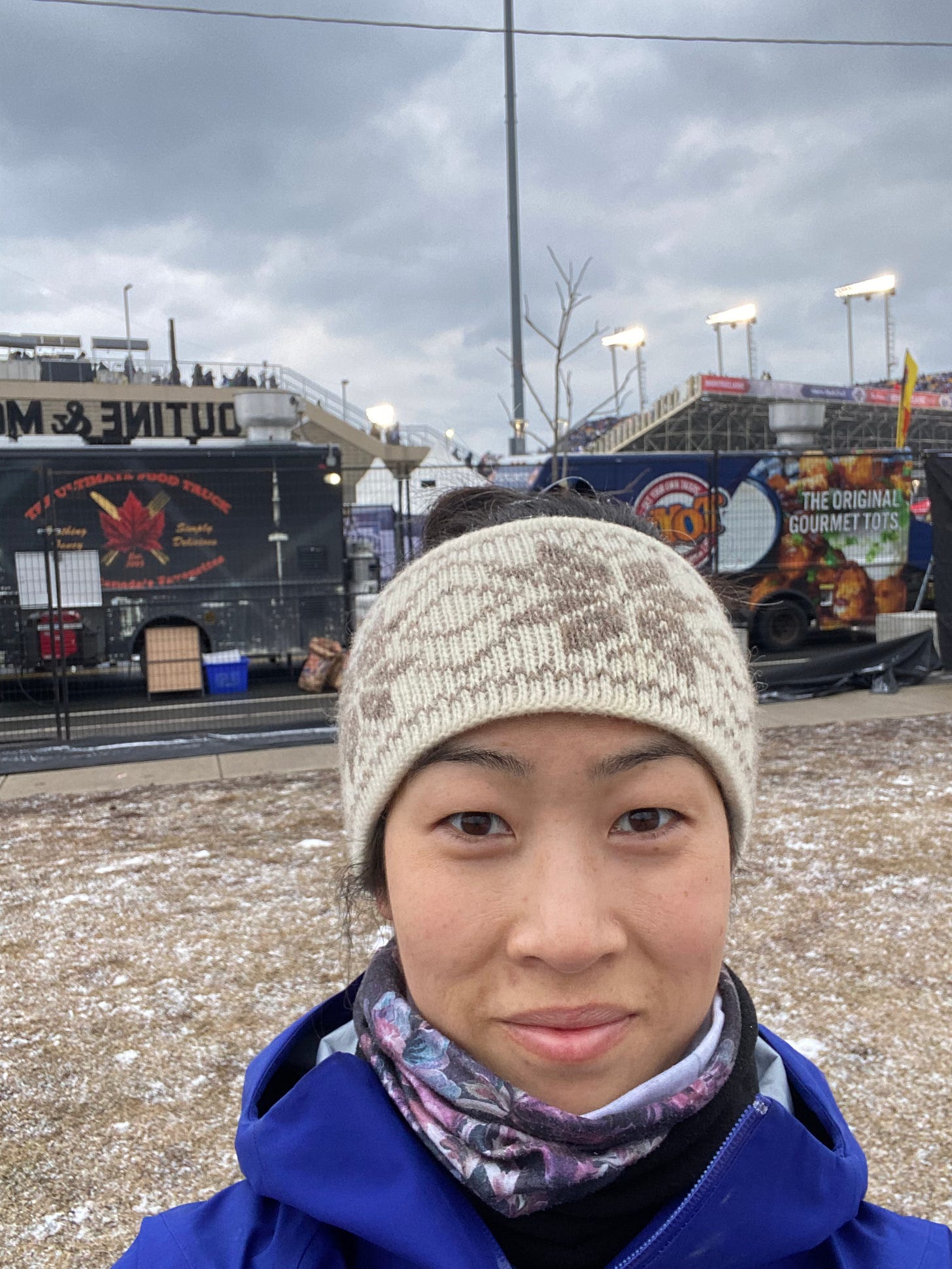What it was like working the 2022 NHL Heritage Classic for the weekend 🏒
Thoughts on transportation operations for big events
Hello friends!
Through friends of Michael, I was offered the very unique opportunity to help out at an event happening in Hamilton last weekend called the NHL Heritage Classic. It’s a special hockey game that only happens every now and then, usually between Canadian teams, but this time was a first for various things:
first Heritage Classic featuring a Canadian v. U.S. team (Toronto Maple Leafs vs. Buffalo Sabres) as opposed to two Cdn teams facing off
first Heritage Classic the Toronto Maple Leafs were playing, ever
first Heritage Classic with this many in attendance (22,000+)
I won’t be talking at all about the game itself (sorry, hockey fans!), but I will relay some of the insight I gained from working behind the scenes and on the ground with the team that delivered the transportation planning for this event.
Transportation for big, one-off events requires some serious planning by people who can get it right the first time.
From what I observed over two days, the Transportation Ops team have two priorities to keep in mind:
facilitate good flow of people and vehicles to avoid pooling and congestion, which can otherwise quickly grind an event to a halt.
“flesh and metal don’t mix” (quote from my area manager), so you want clear separation between these as much as possible.
Good news is that they assembled a team of seasoned transportation and logistics folks who previously worked on delivering various Olympic Games and other sports around the world, so this sounds like it would be an easy peasy job for them… except,
this stadium is located in the middle of… a residential neighbourhood?
If you didn’t catch the tone of surprise in my previous sentence, let me tell you: these are pretty unique conditions for a sports field.
Usually, major venues are located close to mobility hubs (either highways, transit, downtowns…) or with an ocean of parking surrounding it. Or both. But this… is just a giant sports field in the middle of a residential neighbourhood.
So the big question is: How do you get 22,000+ people in and out of this stadium on game day?
The following is speculation on my part, but here are my thoughts on prep:
The whole perimeter of the stadium would need a Venue Flow Plan. There’s a difference between transportation related to the setup of the event, and then the transportation of VIP folks and of actual ticket holders on event day. The three are very different, and a lot of thought is put into avoiding overlap between these, either by blocking off space, or time.
For ticket holders they would have had to do some kind of forecasting on what mode of travel people would be arriving by.
Based on the forecast, they’d create a plan for how to deal with the flow of vehicles and people coming in and out of the stadium area
Then they’d secure all the resources (land for parking, buses for shuttles etc) they needed, based on estimated capacities and frequencies of service needed.
Since the stadium had no on-site vehicular parking, large lots were found off-site which would be serviced by shuttles to the venue. Michael was in charge of running one of these lots on game day.
On top of that, enhanced public transit options were created for this event only. My brother and I were recruited to run one shuttle station each, located within walking distance to the stadium.
I won’t bore you with the particulars of our shuttle zones and our actual tasks on game day. Needless to say, it was a lot of hard work put in by all involved to successfully deliver the plan. And apparently, we crushed it!
What I will share with you is a mental list of big picture things I noticed as I was soaking in the experience.
Define if you’re looking at a “thing”, “talent” or “time” problem
For a chaotic, complex operational environment like this, I found it useful to categorize issues based on these three buckets. If a problem and solution don’t match in type, this could hamper success in delivering a suitable solution. Also, while money is very helpful, know that not every problem can be solved with money alone.
If >80% of the plan was used, it was a good plan
Rarely will absolutely everything go according to plan for big events like this. But the goal is to make a plan that works on semi-autopilot for 80% of the time, while your team irons out all the kinks and exceptions happening on the ground. You don’t want to be solving large structural problems in your plan on game day.
Nothing beats “on the ground” information
While plans are great, things can go awry quickly when the plan hits the ground. It is near impossible to predict local conditions without being there to look and assess what’s going on in the moment. Teams in the field have to be flexible and resourceful for that reason.
Some things are simply out of your hands
There were several times where I had to remind myself that my main responsibility was to take care of the shuttles. Anything extra was great but not essential. Upon seeing my hi-viz gear, many rolled down their windows to ask questions, assuming I knew everything about the event (I didn’t). It took real effort to not feel bad about every customer interaction that I couldn’t turn into a win. This mentality of creating positive customer interactions goes way back to my training when I worked at an amusement park for the summer as a teenager.

Most critical of all: establishing trust and relationships with the people delivering the experience alongside you, from the security guards to the bus drivers.
Most people working the event will be strangers to you, and will remain as such for the rest of your life. But for a precious few hours, you’ll need to operate like a unified, tight-knit group. Saying hi, introducing yourself, priming people by letting them know what may be happening so they mentally prepare (this is so, so important) - all of this is part of building enough trust and coordination to be able to turn on a dime, should it be needed.
Lastly, this has been one of the most spontaneous and enriching experiences I’ve had in a while. Working on an event of this scale and caliber was incredibly exciting. It is so enlightening to understand better how the nitty gritty of such events come together. Having lived in a pandemic world for two years now, seeing a real crowd enjoying themselves, even at a cold-weather outdoor event like this, was heartwarming for sure.
Well, that was fun! Give this letter a ❤️ if you enjoyed it (and pls share the letter with a friend who may appreciate it too!)
Until next time, stay safe and stay curious.
—Fei🪢







Imagining the logistics on this just makes my head spin. SF could probably use a lesson or two!
Oh my! It's like a Will Wright-esque game on steroids. :')